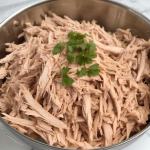8 Lesson 5D
1. Contestar. Watch the video of Judith from Mexico about tamales, and answer the following questions about her favorite traditions.
- ¿Cuándo come tamales la familia de Judith?
- A. Para el Año Nuevo
- B. Para el Día de la Candelaria
- C. Para la Semana Santa
- ¿Qué tipo de tamales NO preparan Judith y su familia?
- A. Tamales de pollo
- B. Tamales de pescado
- C. Tamales de dulce
- D. Tamales verdes
- ¿Qué recuerdo especial tiene Judith sobre los tamales?
- A. Comer tamales para su cumpleaños número 10
- B. Hacer tamales con su familia
- C. Comprar tamales en el mercado
- A investigar. ¿Qué es una tamaliza?
2. Leer. Read the following passage about a popular holiday dish in Mexico.
En México, comer tamales es una tradición muy especial. Los tamales son una comida deliciosa hecha con masa de maíz y rellena con carne, chiles o frijoles. Este plato tiene sus raíces (roots) en antiguas culturas indígenas (indigenous), y hoy en día, los tamales son un plato popular durante festividades y ocasiones especiales como la Navidad y el Año Nuevo. Durante estas festividades, las familias se reúnen (get together) y comparten (share) tamales, creando momentos alegres y comida sabrosa. La preparación de tamales a menudo se hace en comunidad, donde todos ayudan a hacerlos. Es una tradición que une a las personas y celebra la rica cultura mexicana.
Paso 1. Answer the following comprehension questions according to the reading.
- ¿Cuáles son algunos de los ingredientes de los tamales?
- ¿Cuándo se comen los tamales?
- ¿Quiénes comparten los tamales?

Paso 2. Take turns asking your partner the following questions about their favorite holiday dishes.
- ¿Qué plato te gusta comer para un día especial o un día festivo?
- ¿Cuáles son algunos de los ingredientes?
Modelo: Para mi cumpleaños, me gusta comer un pastel noruego (Norwegian). ¡Es muy sabroso! Tiene mantequilla, azúcar y fruta.
3. Emparejar. Look at following recipe for tamales, and match the picture of the ingredient to the list.
Lista de ingredientes:
- 2 tazas de masa para tamales
- 1 taza de manteca derretida de cerdo
- 1 cucharadita de polvo de hornear
- 1 taza de caldo de pollo
- 1 cucharadita de sal
- Hojas de maíz (remojadas en agua caliente)
- Rellenos a elección: pollo desmenuzado (shredded), carne de cerdo guisada, chiles, frijoles, etc.
| Ingredientes | a)  |
|
b) |
c)  |
d) |
e)  |
f) |
g)  |
4. Completar. Read the following instructions for making tamales. Next, fill in the missing infinitive verb for each formal command listed in the chart below.
Instrucciones:
- En un tazón grande, mezcle la masa para tamales, la manteca derretida, el polvo de hornear, el caldo de pollo y la sal. Mezcle bien hasta obtener una masa suave.
- Tome una hoja de maíz suavizada y ponga una capa delgada de masa en el centro de la hoja.
- Añada su relleno favorito, como pollo o carne guisada, en el centro de la masa.
- Doble los lados de la hoja hacia adentro y luego doble los extremos para formar un tamal.
- Repita el proceso.
- Ponga los tamales en una olla grande con un poco de agua en el fondo para cocinar al vapor.
- Cubra los tamales con hojas de maíz y cocine al vapor a fuego medio durante aproximadamente 1.5 a 2 horas.
- Deje reposar los tamales antes de servir. ¡Disfrute de sus tamales mexicanos caseros!
| Expresiones | Infinitivos |
| Disfrute de sus tamales mexicanos caseros. | Modelo: disfrutar |
| Agregue relleno al gusto. | … |
| Deje reposar los tamales antes de comer. | … |
| Doble las hojas para formar el tamal. | … |
| Ponga la masa en el centro de la hoja del tamal. | … |
| Combine la masa, la manteca derretida, el polvo de hornear, el caldo de pollo y la sal | … |
| Cocine al vapor por dos horas. | … |
| Ponga los tamales en una olla. | … |
| Añada el relleno favorito. | … |
5. Preparar una receta.You and your classmate want to make a pizza and a batch of Rice Krispie bars for a Spanish Club gathering. You will each pick one of the recipes below.
Paso 1. Read the steps of your recipe and arrange them in logical order.
|
Estudiante A Una receta para la pizza |
Estudiante B Una receta para unas barras de Rice Krispies |
|
|
Paso 2. Conjugate each underlined infinitive verb into a formal Ud. command.
Paso 3. Share your recipe with your partner to see if they agree with your steps.
6. Crear. Your class wants to have a fun celebration. Work in groups to create a silly/new/inventive recipe for the party. You can use the provided verbs and ingredients or make up your own!
Paso 1. Write out all the necessary steps for your recipe. Be sure to include at least 5 steps, and make sure you conjugate the verbs using Ud. commands.
Paso 2. Share your recipes and the class will vote on their favorite. This will be the one you use for your class party!
Verbos:
| Cortar | Revolver | Mezclar |
| Preparar | Hornear | Cocinar |
| Añadir | Disfrutar | Servir |
| Poner | Extender | Calentar |
Ingredientes:
| Jalapeños | Malvaviscos | Tomates |
| Chocolate | Fresas | Mermelada |
| Pan | Sal | Azúcar |
| Piña | Queso fresco | Tortillas |
7. Leer. Mateo, Sofía, and Diego are roommates at the University of Nebraska. Mateo is giving them commands on what they should do to be good roommates.
Paso 1: Read the following dialogue.
Mateo: ¡Oigan, chicos! Tenemos que organizar el apartamento. Limpien la sala y no dejen sus cosas por todos lados.
Sofía: ¿Otra vez, Mateo? Siempre estás mandándonos.
Mateo: Bueno, pero hay que hacerlo. Laven los platos también, ya hay demasiados que están sucios.
Diego: ¿Y qué vas a hacer tú mientras tanto?
Mateo: Voy a supervisar. Ustedes saquen la basura y no pongan la música tan alta.
Sofía: ¡Qué mandón!
Mateo: Ah, y otra cosa. Hagan la compra porque necesitamos más leche y pan.
Diego: Bien. Voy al supermercado.
Paso 2: Identify all the commands in the dialogue and organize them into Affirmative and Negative commands.
| Affirmative Commands | Negative Commands |
| … | … |
Paso 3: With your partner, look at the verb endings of the commands and compare them to Ud. commands. Discuss how Uds. commands are different.
8. Escribir. You have two new roommates in your apartment. Last night, your roommates had a party. When you woke up, you found your place in need of serious organization. Tell them what they need to do to make the place livable again. Choose from the word bank and use the Uds. Command form.
Banco de palabras: aspirar / lavar / limpiar / hacer / ordenar / secar / sacar
Modelo: Hay basura en la sala. Saquen la basura.
- Los platos están sucios.
- La alfombra tiene comida.
- Las camas no tienen sábanas (sheets).
- El piso está mojado con Coca Cola.
- Los libros están en todas partes.
- El apartamento está desorganizado.
9. Escuchar. Your class and your instructor will take turns giving each other commands using either the Ud. or Uds. form. If the verbs are properly conjugated, the listener must act out the command. If there is a mistake in the conjugation, the listener does not have to do anything. You may choose some actions from the bank or make up your own.
| Acciones | ||
| Saltar (to jump) | Tocar la nariz (las rodillas, el pie, etc.) | Cantar “La Bamba” |
| Bailar un baile popular (por ejemplo, The Floss) | Decir “hola” | Aplaudir |
| Cerrar los ojos | Dar la vuelta | Sacar la lengua (stick out your tongue) |
10. Decidir. Your instructor wrote a list of appropriate and inappropriate behaviors for a Spanish class. However, a colleague decided to mess with them and removed the “no” from some of them.
Paso 1: Read the list of behaviors below.
- Deberían hacer la tarea
- Deberían comer chicle.
- Deberían participar en clase.
- Deberían llegar tarde a clase.
- Deberían usar el teléfono durante la clase.
- Deberían hablar en español
- Deberían tomar notas.
- Deberían hablar mientras el profesor está explicando.
- Deberían copiarse en los exámenes.
- Deberían respetar a sus compañeros.
Paso 2: Categorize each behavior as appropriate or inappropriate for Spanish class by placing them in the correct column.
| Apropiado | Inapropiado |
| … | … |
| … | … |
Paso 3: Discuss with a partner why each behavior is appropriate or not, and come up with 3 additional examples of what to do or not do in class.
11. Recomendar. You and your friends are looking for some suggestions about how to celebrate Valentine’s Day and Thanksgiving next year. Find a partner, and each of you should pick one of these holidays.
Paso 1. Look at the list of holiday-related activities below, and select all the suggestions that correspond to your partner’s holiday.
Lista de actividades:
- Preparar una cena romántica
- Mirar un partido de fútbol americano
- Invitar a todos sus amigos
- Ir al cine
- Comprar flores
- Comer caramelos
- Pasar tiempo con familia
- Cenar en un restaurante
- Visitar a sus abuelos
- Ver el desfile de Macy’s
- Encender velas
- Limpiar la casa
Paso 2. Take turns telling your partner what they and their friends should do to celebrate the holiday. Be sure to use Hay que + infinitivo or Deberían + infinitivo to give your partner suggestions.
Modelo:
| Estudiante A: | Estudiante B: |
| Para el Día de San Valentín… hay que escribir un poema romántico. | Para el Día de la Acción de Gracias…deberían hacer puré de patatas. |
12. Escribir. Using what you have learned in this module, write a paragraph about how to be a good classmate or roommate. Write 6-8 sentences, and be sure to include plural (Uds.) commands, hay que and deberían. You can also use transition words like primero, segundo, luego, además, etc. Be creative!
Modelo:
Es muy fácil ser un buen compañero de cuarto. Primero, ordenen su habitación…

